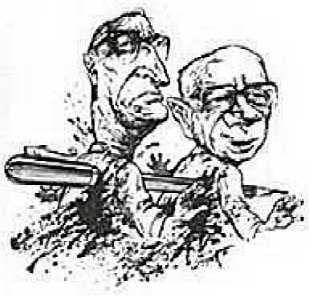 Today marks the centenary of the birth of Pierre Boileau, the elder half of the Boileau-Narcejac writing team. Their internationally famous partnership of the pen was the subject of this marvelously gruesome editorial cartoon (Boileau is the one impaled on the right), which I found on a Russian website; I couldn't find out anything about it, not even the artist's name. As this is one centenary even more likely to be overlooked in our day and age than that of Samuel Beckett (which was in fact commemorated with festivities in Ireland and also here by the Sundance Film Channel, which has been presenting various "Beckett on Film" programs this month), I hope you'll join me in remembering M. Boileau today and, by association, his friend and writing partner. Even if you don't recognize their names, it is virtually guaranteed that you've enjoyed their work.
Today marks the centenary of the birth of Pierre Boileau, the elder half of the Boileau-Narcejac writing team. Their internationally famous partnership of the pen was the subject of this marvelously gruesome editorial cartoon (Boileau is the one impaled on the right), which I found on a Russian website; I couldn't find out anything about it, not even the artist's name. As this is one centenary even more likely to be overlooked in our day and age than that of Samuel Beckett (which was in fact commemorated with festivities in Ireland and also here by the Sundance Film Channel, which has been presenting various "Beckett on Film" programs this month), I hope you'll join me in remembering M. Boileau today and, by association, his friend and writing partner. Even if you don't recognize their names, it is virtually guaranteed that you've enjoyed their work.Pierre Boileau and Thomas Narcejac (real name: Pierre Robert Ayraud) began writing separately and were admirers of each other's books, in which they recognized common interests and diverse approaches. They joined forces in 1951, proposing a new form of mystery fiction that attended not the killer (as in the whodunit), nor the investigator (as in police procedurals), but the victim. Once they began to collaborate, Boileau-Narcejac became one of the great phenomenons of European mystery fiction. Their prose was lean and dialogue-driven, which made it naturally adaptable to the screen. Indeed, their work seeded and brought to bloom some of the finest thrillers ever to grace the screen: Henri-Georges Clouzot's LES DIABOLIQUES (based on their novel CELLE QUI N'ÉTAIT PLUS, translated into English as THE WOMAN WHO WAS NO MORE), Alfred Hitchcock's VERTIGO (based on their novel D'ENTRES LES MORTS, translated as THE LIVING AND THE DEAD), and two directed by Georges Franju, LES YEUX SANS VISAGE (aka EYES WITHOUT A FACE, which they adapted from a novel by Jean Redon) and the original PLEINS FEUX SUR L'ASSASSIN. One of their 1960s novels, translated as CHOICE CUTS, was later the basis for the 1991 thriller BODY PARTS. All told, Boileau-Narcejac receive screen credit on some 40 different films.
In addition to writing thrillers for adults, they also published many mysteries for youngsters and were also responsible for the continuation of two famous "orphaned" characters, Maurice Leblanc's "gentleman burglar" Arsène Lupin and Georges Simenon's Inspector Maigret. In this sense, the Boileau-Narcejac partnership was also post-modernist -- professional mystery fiction written by fans of the genre capable of impersonating earlier literary voices to perfection. Boileau died in 1989, some nine years before his partner. The Criterion DVD of EYES WITHOUT A FACE includes a most enjoyable interview with the two gentlemen, filmed for French television in the 1970s.
English-speaking bibliophiles who aspire to read and/or collect Boileau-Narcejac have a tough row to hoe, and I speak from experience. Dozens of their books remain in print... alas, nearly all of it in French and German. Only a portion of their output has been translated into English at all, and some of that portion appeared only in Great Britain; consequently, what exists is highly collectable. THE LIVING AND THE DEAD was reprinted under the title VERTIGO by the British Film Institute some years ago, but if it should whet your appetite for more, Heaven help you. ABE Books shows that used first editions of their most famous novels in translation are priced in the hundreds, even the thousands.
In VIDEO WATCHDOG #40, I published an article based on my long-overdue reading of THE LIVING AND THE DEAD, in which I compared Boileau-Narcejac's now-obscure novel to the Hitchcock film prized by many as the Master's best. If I had to pick a list of my 10 favorite articles I've written for VW, I might well include it; it's one of the VW pieces I'm proudest of writing, if only because articles comparing novels to films are so much less common than articles comparing different versions of films, and also because there is so little information available in English about this great literary partnership. This issue is still in print, for those of you who missed it -- and now you can even read the novel yourself, which wasn't so easy at the time the article was first published.
Maîtres de mystère, je bois à votre mémoire!